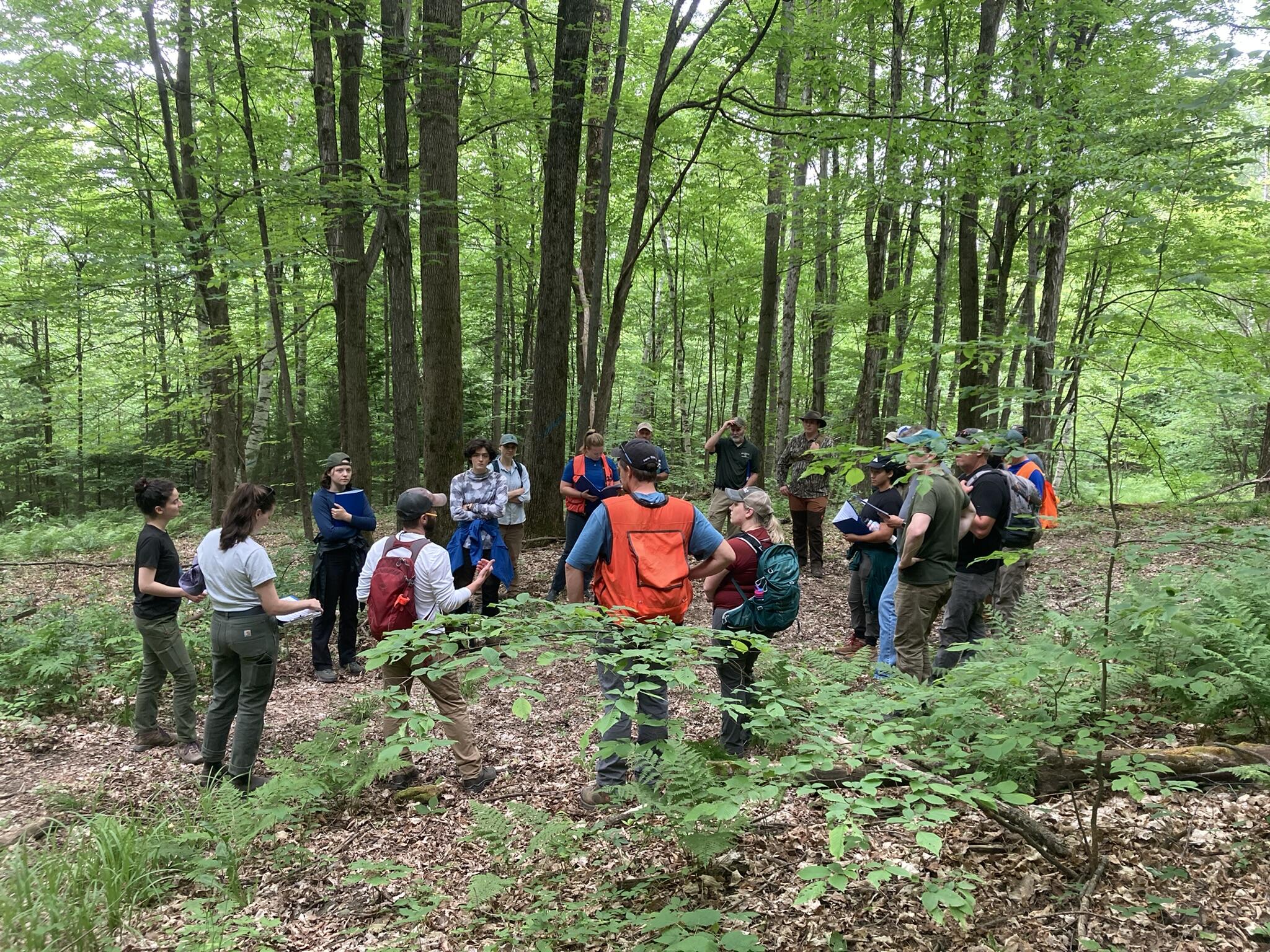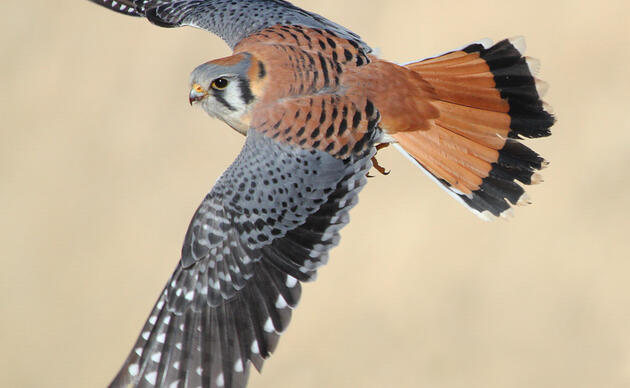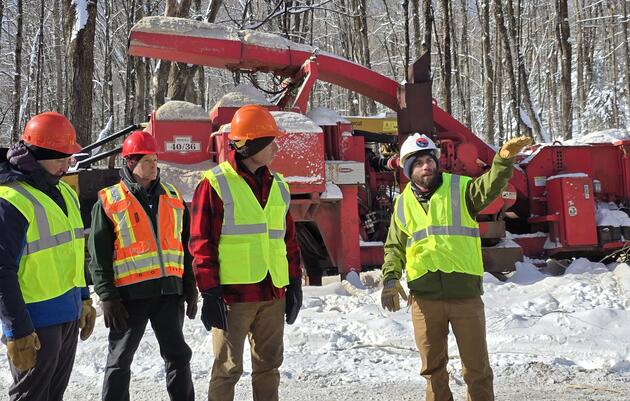Looking to Connect with an Endorsed Forester?
View the Directory of Currently Endorsed Foresters
OR
Looking to Become an Audubon Endorsed Forester?
First, check out this 1-page flier describing the program.
Next, check out this overview of the history of Audubon's Foresters for the Birds program and what we aim to achieve with this new training and endorsement program (so called "Foresters for the Birds 2.0").
Program Details:
Habitat for birds and other wildlife remain one of the primary management objectives for Vermont landowners.
Audubon is excited to offer foresters a new opportunity for assistance in meeting your land management objectives through our new Audubon Forester Training and Endorsement Program. We welcome consulting, agency, industry, and procurement foresters to participate in the program.
Information learned in our training can be applied to private and public land, and is compatible with many objectives, including timber production, water quality, recreation, and carbon sequestration.
The purpose of Audubon’s forester endorsement program is to create a national network of professional foresters working, in partnership with the National Audubon Society, to promote healthy forest ecosystems that provide high-quality habitat for priority bird species, at scale.
An Audubon endorsement means that participating foresters have completed our bird-friendly forestry training curriculum and demonstrated that they can apply the concepts we have taught them. Once endorsed, you will have access to our wide landowner base, and Audubon will promote and support your ongoing habitat work.
OVERVIEW: FROM TRAINING TO ENDORSEMENT
To receive an Audubon endorsement, foresters must complete the following steps (Note: This program is currently in a pilot phase and may change based on feedback provided by participating foresters. Check back for program updates as we work to build a program that benefits foresters and bird conservation.):
- Completing the training webinar series,
- Write an example silvicultural prescription that integrates bird habitat management based on a stand scenario we provide, and
- Provide two examples of new or revised management plans, updates, or amendments that integrate bird habitat management. For large management plans (e.g. public lands, industrial forests, etc.), foresters can revise two stand prescriptions rather than the entire plan.
STEP 1: COMPLETE THE TRAINING WEBINARS TO RECEIVE SAF CFE CREDITS
The pilot program begins with a series of four weekly training webinars, where foresters will learn about birds in decline, landscape and stand-level planning and management to improve forest habitat diversity, resources available to assist foresters, and details about the pilot Audubon Forester Endorsement Program.
Upon completion of the webinar series, foresters can choose to continue with the next steps in the endorsement process. By completing these four sessions, foresters are eligible to receive 4 SAF CFE credits before moving on to the endorsement process.
Training sessions can be accessed at any time and streamed at a time conducive to your schedule. However, we ask that you watch all four sessions before advancing to the next steps of the endorsement process.
SAF CFEs have been approved for recorded webinars (1 Cat 1 CFE per webinar). To receive CFEs for viewing a recorded webinar, foresters will need to submit answers to two questions for each webinar.
How to submit answers: Please submit your answers by either uploading them via the links below, or by emailing them to an Audubon New York or Vermont staff member via the information listed below. Include the subject “CFE Training Questions” along with your SAF or state license identification and we will make sure you receive the necessary credits. We suggest you familiarize yourself with these questions before watching so that you’re prepared to provide answers.
Webinar #1: Forester Training and Endorsement Program and Introduction to the Healthy Forest Initiative
- Watch the recording here
- Upload answers here or email Audubon staff in your state (below)
- Name the four bird species that were discussed during the presentation
- List three threats/stressors to forest habitat quality
Webinar #2: Forest Bird Habitat Management Planning and Assessments
- Watch the recording here
- Upload answers here or email Audubon staff in your state (below)
- To meet the full breeding cycle (nesting and post fledging phases) needs of forest birds, what percentages of a mostly forested landscape should be in young and mature forest age classes?
- Name three stand-level habitat conditions that can be created or improved through forest management.
Webinar #3: Forest Management for Birds
- Watch the recording here
- Upload answers here or email Audubon staff in your state (below)
- To enhance vertical structural diversity within a mature forest using small group selection, what is the approximate size range of groups in acres?
- How many years after a clearcut (2-5+ acres in size) will forest birds start appearing?
Webinar #4: Resources for Foresters, Engaging Landowners and Current Audubon Projects
- Watch the recording here
- Upload answers here or email Audubon staff in your state (below)
- When writing an integrated forest and bird habitat management plan, habitat should be assessed at two different scales or levels and addressed in prescriptions. What are those two scales or levels?
- Please list one location where Audubon has a forest habitat demonstration site.
MOVING PAST TRAINING INTO THE ENDORSEMENT PROCESS
Now that you’ve completed the four endorsement-training sessions you might be asking yourself, what’s next?
You are not obligated to continue past the training into the endorsement process to receive CFE credits however, should you chose to, Audubon will provide access to our wide landowner base while promoting and supporting your ongoing habitat work. We also will remain available to you as a resource when incorporating bird habitat considerations into your forest management planning.
STEP 2: WRITE AN EXAMPLE SILVICULTURAL PRESCRIPTION
Choose one of the mock stand scenarios below and respond to questions provided therein, developing a stand-level prescription that incorporates some of the bird-friendly forestry concepts we outlined in the training. After completion, you can upload your stand prescription here.
Here is an example scenario response.
Choose and address one of the following:
STEP 3: PROVIDE EXAMPLES THAT INTEGRATE BIRD HABITAT MANAGEMENT
Develop two forest management plans (either brand new plans or new activity schedule updates) that incorporate these concepts OR take a previously written plan and add apply these bird-friendly concepts where suitable within the calendar year. For large management plans (e.g. public lands, industrial forests, etc.), you can choose to revise two stand prescriptions rather than the entire plan. For each management plan, we ask you to also complete and cover sheet document found at the bottom of this page.
After completion, upload new or updated management plans here (Importantly: FMP's must be accompanied by a completed cover sheet).
For bird-friendly forest management plans or stand prescriptions, remember to include and tie together the following important components into a plan:
- Describe landowner objectives towards managing their property for birds
- Ensure you present the how and the why behind your proposed management approach, connecting current condition to future habitat.
- Provide a landscape-level assessment
- Quantify and describe forest cover and land use in a 2,500 acre landscape, including, if possible, a map displaying the landscape and areas of suspected or confirmed young forest stands <15-20 yrs old.- see the Audubon Vermont Landscape Analysis Guide using Vermont ANR's Atlas.
- Address forest age class diversity levels at this landscape level:
- Conditions of young forests, <15-20 years old
- Conditions of advanced forest cover, >20 years old
- How do these levels compare to targets for the region of (broadly, 5-10% young forest, 90%+ mature forest).
- Provide a stand-level assessment
- Assess and address stand-level habitat characteristics as they relate to focal groups of bird species (hint: check out the Birders Dozen Pocket Guide and/or Birds with Silviculture in Mind Guide). Habitat elements to describe include: vertical and horizontal structural diversity, native tree species diversity, downed woody material, snags and cavity trees, large diameter trees, etc.
Additional resources for writing prescriptions and management plans:
Audubon New York Forester’s Guide
Audubon Vermont Silviculture with Birds in Mind Guide
A Guide to Integrating Bird Habitat Assessment into a Timber Inventory (to accompany the Inventory Protocol and Field Data Forms).
MAINTAINING ENDORSEMENT
Click here for a guide to our program philosophy and requirements for maintaining endorsement.
--
Additional resources that may help when developing your plans can be found here:
NY Forest Resource Center
VT Forest Resource Center
AUDUBON STAFF CONTACT INFORMATION
- Tim Duclos, Forest Program Senior Associate, Audubon Vermont
- Email: tim.duclos@audubon.org
- Phone: (802) 989-3189
- Suzanne Treyger, Forest Program Manager, Audubon New York
- Email: suzanne.treyger@audubon.org
- Phone: (607) 778–0461
Generously Supported By:
Audubon's Forester Training and Endorsement Program is funded by a Landscape Scale Restoration grant by the U.S Department of Agriculture, Forest Service, an equal opportunity provider, National Fish and Wildlife Foundation New England Forests and Rivers Fund, Davis Conservation Foundation, LuEsther T. Mertz Charitable Trust, Overhills Foundation and High Meadows Fund (now the Daybreak Fund - Vermont Community Foundation).
Additional program support & partners:
- New York and Green Mountain Division - Society of American Foresters
- NYS Department of Environmental Conservation
- VT Woodlands Association
- Forest Stewards Guild
Related
Audubon Announces First-Ever Endorsed Foresters
We are thrilled to share that Caitlin Cusack (Vermont) and John MacNaught (New York) have become endorsed for prioritizing bird habitat in their management recommendations.
Audubon Endorsed Forester Directory
Find a forester that can work with you to develop a bird-friendly forest management plan for your property.
How you can help, right now
Donate to Audubon
Help secure a future for birds at risk from climate change, habitat loss and other threats. Your support will power our science, education, advocacy and on-the-ground conservation efforts.
Visit Audubon
It's always a good time to visit the Audubon Center. Trails are open to the public year-round. Visit us daily from dawn until dusk! Donations are appreciated.
Events
Adults, preschoolers, foresters, photographers, sugarmakers and families will all find opportunities to connect with nature.







